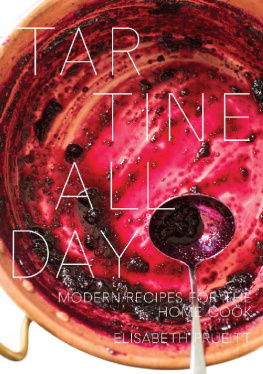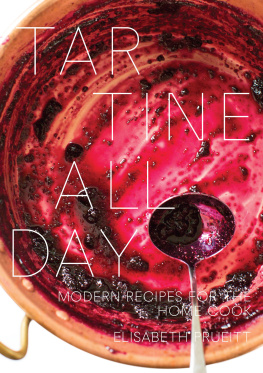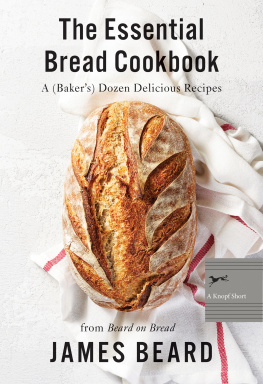All rights reserved.Published in the United States by Ten Speed Press, an imprint of the Crown Publishing Group, a division of Penguin Random House LLC, a Penguin Random House LLC Company, New York.
www.crownpublishing.com
www.tenspeed.com
Ten Speed Press is a registered trademark of Penguin Random House LLC.
Lorena Jones Books and the Lorena Jones Books colophon are trademarks of Penguin Random House LLC.
Library of Congress Cataloging-in-Publication Data Names: Prueitt, Elisabeth M., author.Title: Tartine all day : modern recipes for the home cook / Elisabeth Prueitt.Description: First edition. | California : Ten Speed Press, 2017. | Lorena Jones books. | Includes bibliographical references and index.Identifiers: LCCN 2016049912 (print) | LCCN 2016051149 (ebook) | Subjects: LCSH: Cooking, American--California style. | Tartine (Bakery) | BISAC: COOKING / Regional & Ethnic / American / California Style. | COOKING / Courses & Dishes / Bread. | LCGFT: Cookbooks.Classification: LCC TX715.2.C34 P78 2017 (print) | LCC TX715.2.C34 (ebook) | DDC 641.59794--dc23 LC record available at https://lccn.loc.gov/2016049912
TO MY BELOVED ARCHER AND CHAD
CONTENTS
WHY THIS BOOK NOW
I remember once hearing that cookbooks are the novels of choice for working parents. That they are bedside reading, blueprints for a fantasy time when afternoons would be free enough to bake a cake or when flavor could be considered an equal to convenience in the morning.
Before becoming a parent and business owner, I found this utterly depressing. Of course, I understood indulging in a cookbooks pleasurable writing, but to only read and not cook from a cookbook? One caf, two restaurants, and one nine-year-old daughter later, and I understand that limitations on time can reduce the family meal to a slapdash event on most days. I know that its often easy to forget to pause to really taste the food, and this is despite the fact that I know how to cook well.
You see, theres no way around it: cooking is work. Work in that it requires forethought, a modicum of skill, and time. Work in that you must use your hands, stand on your feet, wash the dishes. (And, full disclosure: for my husband, Chad, and me, cooking is work. It is how we earn our living.) Your simple hope is that while sitting around the table to share the fruits of your labors, the effort fades to memory. Or better yet, the effort becomes part of a meals pleasure, and that the experience of transforming ingredients into a sum greater than their parts connects you to the food in a far more profound way than any recipe lets on. That is the ideal, and to fess up to my own biases, I believe wholeheartedly that its attainable.
Chad and I first met at culinary school in Hyde Park, New York, but we really started to come into our own as cooks when we studied with innovative bakers and pastry chefs, from Massachusetts to France to California. After more than a decade of baking, Chad began to make the bread he was after: a loaf with an old soul. That is, bread with a caramel-colored crust, a moist crumb, and the slightly sour aroma of the natural leaven. I combined classic French pastry techniques with a California aesthetic, drawing upon seasonal fruit and flowers as inspiration. And though this may come as a surprise, I created all of my pastry recipes that would later become favorites at our bakery while tending to a gluten intolerance.
I realize now, after several years of abstaining entirely from gluten (except for naturally leavened breads, like Chads), how physically uncomfortable I truly was. But I discovered this intolerance years before autoimmune disorders were understood, and long before a gluten-free diet was in fashion. Had my intolerance been identified today, I may very well have abandoned wheat early on. But I found an imperfect way to cope with itmastering pastry recipes one minuscule bite at a time. Its said that limitations often become the best teachers. And its true. I was forced to cultivate an acute awareness of how the slightest shift in technique or ingredient altered a pastrys outcome.
Ive brought this same attention to detail and experimentation to working with nongluten flours. It is not an exaggeration to say that there is infinite potential in new recipes and techniques by the very fact that we now have access to such high-quality and diverse flours. I consider myself fortunate that today I can reference my classical training while also abandoning it freely to experiment. Wheat-based recipes, I should say, will always serve as my original reference point. They are what I learned to make first. But a young cook today could happily achieve similarly light textures, crisp crusts, and friable cookies without ever knowing how wheat itself behaves. And thats an exciting development.
However, its certainly worthwhile to know how wheat works, so that we can confidently use ingredients and techniques that do not incorporate it. After all, wheat in all of its formsfrom varietals to types of flourthrives in a bakery setting for a reason. When wheat flour is kneaded, or worked at all, gluten, a substance found in wheat, creates an elastic network between its constituent proteins. This in turn solidifies when heated, giving structure to the baked good. The desired texture and structure are quite different for a loaf of bread than for a piecrust, for example, so the baker works to either develop or minimize the gluten, which helps to achieve the intended form. The baker can also choose from different wheat flours with either low- or high-protein content, which will further aid in this highly manipulative process. While there is no one exact replacement for wheat, its effects can be replicated. For this, we look to an incredible array of nongluten flours to work with, made from grains, legumes, roots, nuts, and in the case of coconut flour, a fruit. Each has unique properties that translate well to particular recipes and often work successfully when combined.
Working with new ingredients is like learning a new language. The basic grammar is the same whether baking with wheat flour or nongluten flours, but the vocabulary is wildly different. And just like the moment when, while learning a new language, you discover a word that has no exact English translation but that opens a world unto itself, baking with nongluten flours has opened my palate to exciting possibilities that I couldnt have thought of when baking only with wheat.
In facing my intolerance, Ive learned one final lesson: its not just ingredients that matter; its also technique. A few years ago, our friend and renowned journalist Michael Pollan was in the midst of writing his book, Cooked. He was studying naturally leavened breads, like Chads, and was coming upon research that suggested that such breads, made with heirloom grains and natural leaven, might be suitable for a person like me: gluten-sensitive but without celiac disease. Chad and I recalled how years ago during our stay in the Savoie region of France, I could eat the bread he was baking with his mentor without issue. Any other wheat-based food in France, and in the States when I returned, caused too much discomfort to be worth eating. Michaels research highlighted the link between enhanced digestibility and the fermentation enacted by a natural leaven, suggesting that such breads might actually work for me. Miraculously, it is true. I can eat Chads bread, and any other made in the same way. Science is finally answering our decades-old question, and it turns out it has everything to do with both ingredient and technique. For example, our friend, producer/director J.D. McLelland, is working on a project (and film) known as Ingrained. The project is focused on grain breeding, growing, and processing, as new insights and science emerge to reveal just how much more there is to know about the subject.










